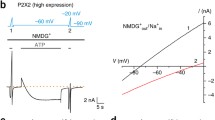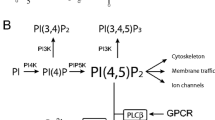Abstract
Some cation permeable ligand-gated ion channels, including the capsaicin-sensitive TRPV1, have been reported to exhibit a time-dependent increase in permeability to large inorganic cations during sustained activation, a phenomenon termed “pore dilation.” TRPV1 conducts substantial Ca2+ entry, and it has been suggested that this channel undergoes a time-dependent change in Ca2+ permeability relative to Na+ (P Ca/P Na) that parallels pore dilation. However, our experiments employing whole cell patch clamp photometry and single channel recordings to directly measure relative Ca2+ current in TRPV1 expressing HEK293 cells show that relative Ca2+ influx remains constant for the duration of capsaicin-evoked channel activation. Further, we present evidence from patch clamp photometry experiments suggesting that sustained activation of Ca2+ permeable ion channels in the voltage-clamp configuration leads to rapid saturation of the pipette Ca2+ chelator, and that subsequent observed shifts in the current reversal potentials in the presence of extracellular Ca2+ are likely due to intracellular accumulation of this ion and a movement of the Ca2+ equilibrium potential (E Ca) towards zero. Finally, using an adapted reversal potential-based protocol in which cells are only exposed to Ca2+ after sustained capsaicin exposure in the absence of added extracellular Ca2+, we demonstrate that the calculated P Ca/P Na is unaffected by duration of TRPV1 activation. In conclusion, we find no evidence in support of a time-dependent change in P Ca/P Na for TRPV1. Our data further urges caution in estimating relative Ca2+ permeability using reversal potentials, as there is a limited time window in which the cytosolic Ca2+ chelator included in the patch pipette can prevent localised elevations in cytosolic free Ca2+ and thus allow for an accurate estimate of this important channel permeability parameter.




Similar content being viewed by others
References
Ahern GP, Brooks IM, Miyares RL, Wang XB (2005) Extracellular cations sensitize and gate capsaicin receptor TRPV1 modulating pain signaling. J Neurosci 25:5109–5116
Banke TG, Chaplan SR, Wickenden AD (2010) Dynamic changes in the TRPA1 selectivity filter lead to progressive but reversible pore dilation. Am J Physiol Cell Physiol 298:C1457–C1468
Berridge MJ, Bootman MD, Roderick HL (2003) Calcium signalling: dynamics, homeostasis and remodelling. Nat Rev Mol Cell Biol 4:517–529
Burnashev N, Zhou Z, Neher E, Sakmann B (1995) Fractional calcium currents through recombinant GluR channels of the NMDA, AMPA and kainate receptor subtypes. J Physiol 485(Pt 2):403–418
Caterina MJ, Schumacher MA, Tominaga M, Rosen TA, Levine JD, Julius D (1997) The capsaicin receptor: a heat-activated ion channel in the pain pathway. Nature 389:816–824
Chung MK, Guler AD, Caterina MJ (2008) TRPV1 shows dynamic ionic selectivity during agonist stimulation. Nat Neurosci 11:555–564
Egan TM, Khakh BS (2004) Contribution of calcium ions to P2X channel responses. J Neurosci 24:3413–3420
Eisenman G, Horn R (1983) Ionic selectivity revisited: the role of kinetic and equilibrium processes in ion permeation through channels. J Membr Biol 76:197–225
Fucile S (2004) Ca2+ permeability of nicotinic acetylcholine receptors. Cell Calcium 35:1–8
Fucile S, Sucapane A, Eusebi F (2005) Ca2+ permeability of nicotinic acetylcholine receptors from rat dorsal root ganglion neurones. J Physiol 565:219–228
Grynkiewicz G, Poenie M, Tsien RY (1985) A new generation of Ca2+ indicators with greatly improved fluorescence properties. J Biol Chem 260:3440–3450
Hille B (2001) Ion channels of excitable membranes, 3rd edn. Sinauer Associates
Hille B (1971) The permeability of the sodium channel to organic cations in myelinated nerve. J Gen Physiol 58:599–619
Jatzke C, Hernandez M, Wollmuth LP (2003) Extracellular vestibule determinants of Ca2+ influx in Ca2 + -permeable AMPA receptor channels. J Physiol 549:439–452
Jatzke C, Watanabe J, Wollmuth LP (2002) Voltage and concentration dependence of Ca(2+) permeability in recombinant glutamate receptor subtypes. J Physiol 538:25–39
Karashima Y, Prenen J, Talavera K, Janssens A, Voets T, Nilius B (2010) Agonist-induced changes in Ca(2+) permeation through the nociceptor cation channel TRPA1. Biophys J 98:773–783
Khakh BS, Bao XR, Labarca C, Lester HA (1999) Neuronal P2X transmitter-gated cation channels change their ion selectivity in seconds. Nat Neurosci 2:322–330
Koplas PA, Rosenberg RL, Oxford GS (1997) The role of calcium in the desensitization of capsaicin responses in rat dorsal root ganglion neurons. J Neurosci 17:3525–3537
Lewis CA (1979) Ion-concentration dependence of the reversal potential and the single channel conductance of ion channels at the frog neuromuscular junction. J Physiol 286:417–445
Li M, Toombes GE, Silberberg SD, Swartz KJ (2015) Physical basis of apparent pore dilation of ATP-activated P2X receptor channels. Nat Neurosci. doi:10.1038/nn.4120
Munns CH, Chung MK, Sanchez YE, Amzel LM, Caterina MJ (2015) Role of the outer pore domain in transient receptor potential vanilloid 1 dynamic permeability to large cations. J Biol Chem 290:5707–5724
Neher E (1995) The use of fura-2 for estimating Ca buffers and Ca fluxes. Neuropharmacology 34:1423–1442
Premkumar LS, Agarwal S, Steffen D (2002) Single-channel properties of native and cloned rat vanilloid receptors. J Physiol 545:107–117
Samways DS, Egan TM (2007) Acidic amino acids impart enhanced Ca2+ permeability and flux in two members of the ATP-gated P2X receptor family. J Gen Physiol 129:245–256
Samways DS, Egan TM (2011) Calcium-dependent decrease in the single-channel conductance of TRPV1. Pflugers Arch 462:681–691
Samways DS, Harkin AB, Egan TM (2009) Native and recombinant ASIC1a receptors conduct negligible Ca2+ entry. Cell Calcium 45(4):319–325
Samways DS, Khakh BS, Egan TM (2012) Allosteric modulation of Ca2+ flux in a ligand-gated cation channel (P2X4) by actions on lateral portals. J Biol Chem. doi:10.1074/jbc.M111.322461
Samways DS, Khakh BS, Egan TM (2008) Tunable calcium current through TRPV1 receptor channels. J Biol Chem 283:31274–31278
Samways DS, Migita K, Li Z, Egan TM (2008) On the role of the first transmembrane domain in cation permeability and flux of the ATP-gated P2X2 receptor. J Biol Chem 283:5110–5117
Skeberdis VA, Chevaleyre V, Lau CG, Goldberg JH, Pettit DL, Suadicani SO, Lin Y, Bennett MV, Yuste R, Castillo PE, Zukin RS (2006) Protein kinase A regulates calcium permeability of NMDA receptors. Nat Neurosci 9:501–510
Virginio C, MacKenzie A, Rassendren FA, North RA, Surprenant A (1999) Pore dilation of neuronal P2X receptor channels. Nat Neurosci 2:315–321
Watanabe J, Beck C, Kuner T, Premkumar LS, Wollmuth LP (2002) DRPEER: a motif in the extracellular vestibule conferring high Ca2+ flux rates in NMDA receptor channels. J Neurosci 22:10209–10216
Acknowledgments
We thank Dr. David Julius (UCSF, CA) for supplying the rat TRPV1 cDNA, and Dr. Terrance Egan (St. Louis University, MO) for discussion and suggestions during the preparation of this manuscript.
Author information
Authors and Affiliations
Corresponding author
Electronic supplementary material
Below is the link to the electronic supplementary material.
Supplemental Figure 1
Rare TRPV1 subconductance state observed in small number of patches showed no time-dependence or signs of altered relative permeability. Single channel currents were recorded from outside-out patches pulled from HEK293 cells transfected with wild-type or mutant TRPV1 receptors. A) Representative trace recorded in a TRPV1-expressing membrane patch in symmetrical Na+ (150 mM) with no-added Ca2+ exhibiting a rare capsaicin-sensitive subconductance state. Where the subconductance state (open circles) was observed at different membrane potentials (B) and extracellular ionic environments (C), the relative amplitude to the main conductance state (closed circles) was generally consistent. (PNG 159 kb)
Rights and permissions
About this article
Cite this article
Samways, D.S.K., Tomkiewicz, E., Langevin, O.M. et al. Measurement of relative Ca2+ permeability during sustained activation of TRPV1 receptors. Pflugers Arch - Eur J Physiol 468, 201–211 (2016). https://doi.org/10.1007/s00424-015-1741-1
Received:
Revised:
Accepted:
Published:
Issue Date:
DOI: https://doi.org/10.1007/s00424-015-1741-1




